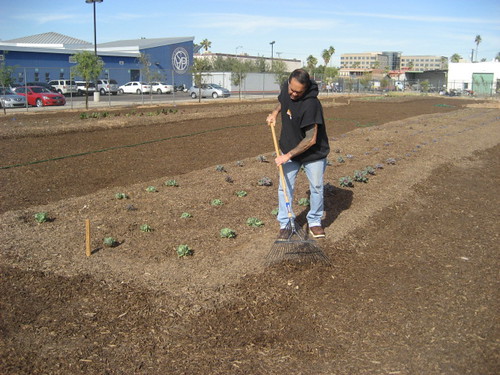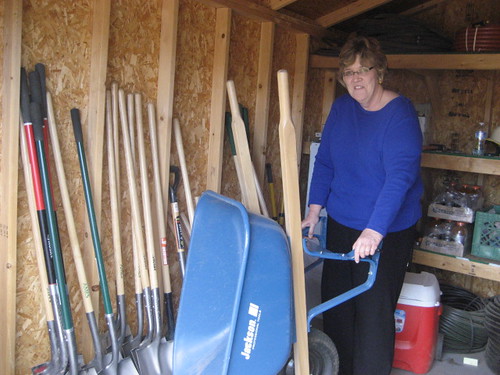There has been little in Ruben Herrera’s life of late to celebrate. The past few years have been marred by drugs, prison, and homelessness.
A military vet who was raised on a farm in Gilbert, Arizona, Ruben remembered the sweetness of his childhood rural lifestyle even as he struggled with the realities of life on the streets of America’s sixth largest city.
In October, Ruben’s Veterans Administration counselor directed him to the Human Services Campus in downtown Phoenix where he is now finding renewed hope and purpose.
The Human Services Campus houses several social service agencies—St. Vincent de Paul, Central Arizona Shelter Services, Lodestar, NOVA Safe Haven, Maricopa County Health Services and St. Joseph the Worker employment counseling. But for Ruben, the Community Garden, rooted out of a parking lot next to the campus, has become his sanctuary.

“It’s a beautiful place,” he explained. “It just makes me happy to be here.”
Ruben is a trained iron worker and carpenter. Besides his gardening, he is also building wooden benches to put into the garden so that others at the Campus can find the peace and relaxation that sitting there brings. “Whatever issues I might have, when I come to work in the garden, I feel peaceful and relaxed,” he said.
The garden covers a one acre parcel next to the Campus. Food from the garden will be used to help feed the homeless at the St. Vincent de Paul’s charity dining room next door.
A shed full of donated gardening supplies—rakes, shovels, wheelbarrows—sits at the back of the property where volunteers, many of whom live at the homeless shelter, can access them at will. A few minutes, or even a few hours, of working in the soil can be powerful therapy.
Cathy Eden, a former state representative, headed a committee of human service advocates who have long hoped to see this project developed.
Early on Eden approached USDA Rural Development to ask about resources for the project. USDA provided Eden with information on the People’s Garden initiative and arranged meetings and teleconferences between Eden and the Arizona offices of USDA’s Farm Service Agency and Natural Resource and Conservation Service. Beside the technical assistance from USDA, Eden and the committee were able to collect $100,000 worth of donated materials, including seeds, soil, and sprinklers.
Now, close to its first harvest of winter crops—lettuces, cabbage, chard—the garden has the feel of an oasis—shade trees surrounding the perimeter, neatly tended rows of crops.

Ruben has a real sense of ownership of the garden. “It’s like my responsibility,” he said. “I’m a hard worker and I like to beautify things.” Glancing over the field he saw an errant rock—walked over and picked it up and placed it along the fence line. “It’s so beautiful; I want to keep it that way.”
There is no doubt that Ruben finds the whole experience comfortable. “If not for this place, I might be back in prison,” he said. “Now, I have a bed and the resources available here to find myself again.”
“And mostly”, he said, “I have a beautiful garden to work in. I love tending this garden. When I’m 80 years old, I hope to come out here and just sit!”
To find out more about how your community can benefit from a community garden, click here. And for additional ideas about resources for local food and community gardens at the Know Your Farmer, Know Your Food Compass.
